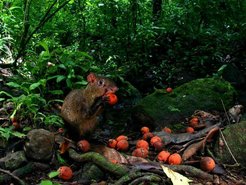The internet of animals

To this day, behaviour research continues to be gruelling work. For example, chimpanzee researchers in Africa need to trek for hours every day through dense rainforest. It is only by arriving at the sleeping nests of a group of chimpanzees punctually at sunrise that they can accompany the animals during the day and document their behaviour. Then it's back to the camp every evening. This routine can continue for weeks at a time.
Even if not every species of animal is so difficult to observe - anyone who wants to get to know the natural behaviours of animals needs plenty of stamina, physical endurance and patience. Modern telemetry – the collection and evaluation of data using sensors – can make this arduous and time-consuming process largely superfluous. This marks a revolution for behaviour research and ecology, and Icarus is part of this revolution!
In future, the transmitters will be able to tell scientists much of what they previously found out only after hours of observation. While the transmitters record the data and relay it in real time via satellites, the researcher, in certain cases, is sitting thousands of kilometres away in his or her research lab and can start to analyse the measurement results straight away.
Icarus's objective is to make behavioural research and ecology more pleasant for the researchers. The progress made in telemetry also facilitates completely new insights into nature. For the first time, it will be possible to determine the location and movements of an animal in real time and on a large scale with thousands of animals.
One example is migratory birds. Many bird species migrate around the world year after year. For decades, bird researchers have ringed young birds and hoped to subsequently find some of them again. As a result, we know in certain cases where some birds migrate to and the route they take. Due to the low number of rings that are found again, it can also be concluded that the death rate on their travels must be high. But we don't know exactly how many animals actually die and where and why they perish, not to mention the many species whose flight paths are completely unknown.

Modern telemetry will bridge many of the gaps in this knowledge. For example, researchers in Denmark and southern Sweden have equipped common cuckoos (Cuculus canorus) with mini-transmitters and tracked them for a year using the satellite-based ARGOS locating system. The researchers were able to track three of the birds over their 16,000-kilometre, ten-month-long loop migration to Central Africa and back and in the process gained surprising insights. In the Icarus initiative, ornithologists want to accompany even more animals – especially smaller animals – on their travels.
There are other animals where it is not known whether they even migrate at all. In the case of some species, only a few individuals migrate. These are frequently young animals. Telemetric studies have revealed that large land-based predators like pumas and jaguars also cover great distances. Individual animals migrate back and forth between habitats and thus contribute to the genetic exchange between various populations – an important finding that scientists need to consider if they want to assess the survival chances of these populations.
The movement pattern of animals also teaches researchers how an organism influences its ecosystem – as a herbivore, predator or parasite. Many animals also serve as transport vehicles. They carry stowaways in their fur or feathers: plant seeds, insects, fish or amphibian spawn. Others, like the straw-coloured fruit bats in Ghana, transport plant seeds in their digestive tract on their daily flight from their feeding places to their sleeping places. A fruit bat can cover up to 400 kilometres in one night. Researchers believe that up to 96 percent of trees in the African rainforest are the result of fruit bat excretions.
Rodents, such as the agoutis in the South American rainforest, or the oilbird, a bird in Venezuela, fulfil the same purpose. All of these species perform essential services for a functioning ecosystem – ecologists refer to such services as “ecosystem services”. Up until now, scientists have known about only a fraction of these, as too little is known about the movement profiles of most species.
Modern telemetry systems like Icarus can now do much more than simply reveal movements and migratory routes: in addition to collecting location and movement data, the transmitters also collect information about the physical condition of an animal. This includes body temperature, blood pressure, pulse rate or even the blood's sugar and oxygen levels. Mini-cameras can provide further details such as what an animal eats or how many young it has.

While this accounts for much more information than currently exists for most animal species, it nevertheless reveals only part of their living situation. Scientists therefore want to combine their data with measurements of the animals' environmental conditions. For this reason, they are developing transmitters for telemetry, which can also measure ambient temperature, air pressure, wind or airflow rate. Together with the satellite recordings and the data from weather and other measurement stations, this will round out our knowledge of the lives of animals.


